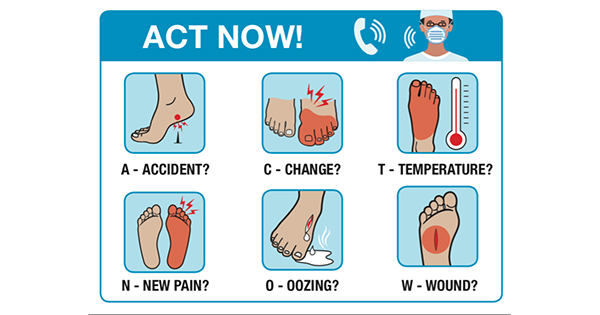In 1989 the St Vincent Declaration set a target to reduce lower extremity amputations (LEAs) due to diabetic gangrene by 50% over 5 years. While there is no shortage of studies that measure diabetes-related lower extremity amputation (DRLEA) rates worldwide, a wide range of different methodologies are used, making useful comparison difficult and hampering the monitoring of progress towards the St Vincent’s targets.
The Global Lower Extremity Amputation Study (GLEAS) was set up to record population-based LEA data for people with and without diabetes from 10 centres in the USA, Europe and East Asia. It used a standard data collection protocol in each of the centres to enable the calculation of accurate population-based LEA rates for the centres involved, and comparisons between the centres.
Aims
In our study we set out to establish accurate population-based LEA rates for people with and without diabetes in four English centres (Leicester, Leeds, Middlesbrough, Newcastle) enrolled in GLEAS. We wished to establish whether geographic variation in LEA rates existed in the UK, as for other countries, and to develop hypotheses for any variations seen.
Research methods
Materials and methods have previously been published (LEA study group, 2000). A manual describing the method of data collection is available from one of the authors (NU). LEA was defined as complete loss of any part of the lower limb for any reason, in the following anatomical planes: in the transverse anatomical plane proximal to, and including, the subtalar joint, and in the frontal anatomical plane distal to the subtalar joint. A major LEA was defined as through, or proximal to, the tarsometatarsal joint and a minor LEA as one distal to this joint.
All cases of LEA in the four centres were collected over 2 years from 1 July 1995 to 30 June 1997. Three or more data sources (e.g. operating theatre records, limb-fitting centre, hospital discharge data, surgical records, foot clinic, diabetes care centre) were used to identify cases. Completeness of the dataset was estimated using capture-recapture methodologies (International Working Group for Disease Monitoring and Forecasting, 1995). Case ascertainment was estimated at greater than 70% in all centres and approached 100% in two of the centres (Leeds, Middlesbrough).
A standardised data extraction form was completed from patients’ medical records for age, sex, postcode, ethnicity, smoking habit, first or subsequent amputation, diabetes status, duration of diabetes, insulin treatment and level of amputation. LEA rates were calculated for each centre for sex, 20-year age bands, and for people with and without diabetes.
The background demographics of the four centres from 1991 UK census data are shown in Figure 1. Of note, the centre Leicester included all of the county of Leicestershire, i.e. both city and county. Between the centres there was a socio-economic gradient of increased material deprivation from North to South.
The denominator populations for non-DRLEAs were 1996 mid-year estimates based on 1991 UK census data minus the population with diabetes. Local population-based prevalence figures for diabetes in three of the centres were lacking. In Middlesbrough there has been a community-based diabetes register in operation since 1994, which identifies the local population known to have diabetes. An age-standardised diabetes prevalence of 1.74% in 1994 for Middlesbrough is in keeping with other comparable determinations of diabetes prevalence. Standardised diabetes prevalence figures for each of the other centres have been calculated using the Middlesbrough diabetes prevalence rates.
The World Health Organization (1993) defined European standard population was used for direct age standardisation.
Results
Populations in the four centres varied from 283100 to 732055, with a combined study population of 2.23 million. A total of 940 cases of LEA were identified over 2 years, of which 404 (43.0%) were diabetes related. The percentage of DRLEAs varied from 29.8% (Newcastle) to 52.6% (P<0.0005) (Middlesbrough). Of the 940 cases, 48 (5.1%) involved trauma, and these were included in subsequent calculations. The percentage of cases involving trauma in each centre ranged from 2.3% to 9.2% (P<0.01).
Age-adjusted DRLEA rates were in excess of non-DRLEA rates for all centres. Age-adjusted DRLEA rates per 100000 people with diabetes per year were 110.3, 416.9, 446.0, and 205.2 for Leicester, Leeds, Middlesbrough and Newcastle respectively (Figure 2). The rate in Middlesborough (the centre with the highest rate) is 4.0 (95% CI: 3.2–4.9) times that in Leicester (the centre with the lowest rate). A similarly large degree of variation exists between centres for non-DRLEAs where rates per 100000 persons per year are 3.5, 19.4, 14.4 and 16.6 for Leicester, Leeds, Middlesbrough and Newcastle, respectively (Figure 2). The figure shows that the rate is highest in Leeds, and 5.6 (95% CI: 5.0–6.3) times that of Leicester.
The age-adjusted relative risk for a person with diabetes undergoing LEA compared with a person without diabetes varied from 12.5 (95% CI: 10.4–19.3) in Newcastle to 31.6 (95% CI: 25.5–42.0) in Leicester.
The differences between centres were less extreme for first major LEA, e.g. the first major DRLEA rate in Middlesbrough is 2.8 (95% CI: 1.9–4.0) times that in Leicester (Figure 3). First major non-DRLEA rates vary 4.0-fold (95% CI: 3.0–5.3), the centre with the highest rate being Newcastle and the centre with the lowest being Leicester.
First major DRLEA rates by sex show a greater variability for men than for women. For men the difference between the centre with the highest first major DRLEA rate (Middlesbrough 174.7) and the centre with the lowest (Leicester 42.5) is 4.1-fold (95% CI: 2.6–6.0). For women the difference between the centre with the highest rate (Leeds 122.8) and lowest rate (Leicester and Newcastle jointly 73.2) is 1.7-fold (95% CI: 1.1–2.5).
Similarly, first major non-DRLEA rates show a greater variability for men than for women. First major non-DRLEA rates for men are greatest in Middlesbrough (11.8) and lowest in Leicester (2.2) varying 5.4-fold (95% CI: 3.6–7.9). For women the difference between the centre with the highest (Newcastle 5.5) and the lowest (Leicester 1.9) rate is 2.9-fold (95% CI: 1.8–4.4).
The repeat major DRLEA rate in men was significantly higher in Middlesbrough compared with the other centres. The ratio of repeat to first major DRLEA for men was 0.3, 0.2, 0.8 and zero (no repeat major DRLEA over 2 years) (95% CI: 0.1–0.7, 0.1–0.4, 0.5–1.3, 0–0.3) for Leicester, Leeds, Middlesbrough and Newcastle respectively. The ratio of repeat to first major non-DRLEA for men was 0.4, 0.2, 0.2 and 0.4 (95% CI: 0.2–0.8, 0.1–0.3, 0.1–0.4, 0.2–0.7) for the same four centres.
Minor LEAs were less frequent than major LEAs in three of the centres, Leeds being the exception. The minor to major LEA ratios for persons with and without diabetes were less than or equal to1.0 in all centres, except for Leeds where the minor to major ratios for DRLEAs and non-DRLEAs were 1.5 and 1.1 respectively.
People with diabetes had proportionately more minor LEAs than people without diabetes in all centres. The minor to major ratios for DRLEAs were 0.6, 1.5, 0.8 and 1.0 (95% CI: 0.4–0.9, 1.2–1.8, 0.6–1.1, 0.6–1.5) compared with 0.4, 1.1, 0.5 and 0.5 (95% CI: 0.2–0.6, 0.9–1.3, 0.3–0.7, 0.3–0.7) for non-DRLEAs for Leicester, Leeds, Middlesbrough and Newcastle respectively.
Discussion
This study confirms the high relative risk of LEA for people with diabetes compared with those without diabetes. DRLEA rates ranged from 12.5 times (Newcastle) to 31.6 times (Leicester) non-DRLEA rates. Although people with diabetes make up 1.74% of the total population in the four centres, they account for 29.8–52.6% of all LEAs.
Leicester had the lowest recorded LEA rates, both for people with diabetes and those without diabetes (110.3 and 3.5 per 100000 people with and without diabetes). The highest DRLEA rates were recorded in Middlesbrough (446.0 per 100000 people with diabetes) and the highest non-DRLEA rates were recorded in Leeds (19.4 per 100000 people without diabetes).
The degrees of variation between the centre with the highest and lowest rates for DRLEAs and non-DRLEAs were 4.0 and 5.6 respectively. This degree of variation between highest and lowest rates was less extreme when first major LEAs were looked at, being 2.8 for DRLEAs and 4.0 for non-DRLEAs.
Men showed a greater degree of variation in LEA rates than women. The degrees of variation for first major DRLEAs and non-DRLEAs rates among men were 4.1 and 5.4 respectively, while for women they were 1.7 and 2.9.
The high DRLEA rate in Middlesbrough is partly explained by a high number of repeat major LEAs among men. The ratio of repeat to first major DRLEA for men was 0.8 for Middlesbrough compared with 0.3 to 0 for the other centres. This was not reflected in first major non-DRLEA rates for men. Minor to major LEA ratios for DRLEAs were greater than for non-DRLEAs in all centres, reflecting the increased number of minor LEAs among people with diabetes. Leeds had a disproportionate number of minor LEAs compared with the other centres, both for people with and without diabetes, with both DRLEAs and non-DRLEAs minor to major LEA ratios >1 (1.5 and 1.1).
This is a relatively up-to-date incidence study, which provides one of the most accurate determinations of DRLEA and non-DRLEA rates for England. Until recently, good population-based DRLEA and non-DRLEA rates for England were lacking.
A major strength of our study is the inclusion of multiple centres across England, with data collected in a standardised way. This allows useful comparisons to be made within and between regions. Geographic variation can thus be quantified and examined. Unfortunately, as in many other disease processes, the reasons for geographic variation in rates of LEAs are not clearly understood (Variations Sub-Group of the CMO’s Health of the Nation Working Group, 1995).
Geographic variation in LEA rates has not previously been described in the UK. The extent of geographic variation for LEAs reported here is in keeping with that reported in other countries. In the USA, Wrobel et al (2001) found variations across hospital referral regions for the whole of the Medicare population of 8.6-fold for DRLEA and 6.7-fold for non-DRLEA for major amputations. Van Houtum and Lavery (1996) found a 4.4-fold difference in DRLEA rates reported in the 27 health regions of the Netherlands.
Another strength of this study is the use of multiple data sources to identify cases, enabling levels of ascertainment to be estimated. Knowing the ascertainment rate is important in validating comparisons of LEA rates between centres.
It is possible that people from the populations studied could have had LEAs performed away from the centres to which the populations are attributed. The use of different sources, such as data from limb fitting and diabetes care centres, to determine cases increases the chances of picking up such cases. However, it is possible that some people will not come in contact with any of these potential data sources.
The chances of this happening would presumably be more likely the greater the number of potential alternative centres in close proximity to the centres studied. There is no evidence to suggest that at the four centres (all with established vascular services) patients seek care away from their local centres. However, even allowing for a correction of 50% of all LEAs within a population being performed beyond the local centre, differences between centres are still highly significant (P<0.0005).
The diabetes prevalence used for our centres is the same throughout. It has been derived from a community-based diabetes register for Middlesbrough. In 1994, Middlesbrough had an age-adjusted diabetes prevalence of 1.74%. This figure compares favourably with other published community-based prevalence figures at the time (Morris et al, 1997; Gatling et al, 1998).
A real difference between the centres in terms of diabetes prevalence could account for some of the variation seen, but currently little is known about variation in diabetes prevalence across the UK. Even less is know about regional variation in prevalence of dyslipidaemia, peripheral vascular disease (PVD) and peripheral neuropathy. Although individually these risk factors may not vary significantly across regions, collectively they may impact on the number of LEAs.
Factors that determine the incidence of LEAs in and between regions can be of two main types: (1) differences in population characteristics and (2) differences in health service provision, e.g. due to clinical practice, health service organisation and patient access to services.
There is evidence of differences in population characteristics from epidemiological data. The percentage of the populations of non-white ethnic origin varies from 1.9% to 11.1% (P<0.0005), being lowest in Middlesbrough and highest in Leicestershire. A low incidence of LEA in populations of Asian descent is well recognised (Gujral et al, 1993). This is also true for DRLEAs, which are relatively less common in patients of Asian descent despite the high prevalence of diabetes in these populations (Mather and Keen, 1985).
A significant regional variation in PVD might account for some of the difference in LEA rates found. While PVD incidence is poorly documented at regional level, data on other indicators of vascular disease such as stroke are more routinely available. For stroke the highest levels are recorded in the Northern and Yorkshire region (age-standardised rate per 1000 men 2.8, women 2.2). Lower rates are recorded in the health region to which Leicestershire belongs, i.e. Trent (age-standardised rate per 1000 men 2.2, women 1.6). This variation in stroke incidence appears modest, compared with the geographic variation found for LEA. Prevalence of cigarette smoking, a known risk factor for PVD, is 33% and 31% for men and women in the Northern health region, but only 29% and 27% in the Trent health region (Variations Sub-Group of the CMO’s Health of the Nation Working Group, 1995).
Socioeconomic deprivation has been shown to be associated with increased prevalence of type 2 diabetes, poor glycaemic control, cardiovascular risk factors, complications, and hospital admissions (Caddick et al, 1994; Kelly et al, 1994; Unwin et al, 1996; Connolly et al, 2000; Muhlhauser et al, 2000).
Also, worsening material deprivation is associated with excess mortality for persons with diabetes, mostly through cardiovascular causes (Roper et al, 2001). Masson et al (1989) demonstrated a trend towards diabetic foot ulceration in socioeconomically deprived groups. In Middlesbrough, 26.6% of the population are in social classes IV or V, whereas in Leicestershire only 18.5% (P<0.0005) are in these same social classes. It would seem likely that socioeconomic status is related to LEA rates, although no link has yet been proven.
Early recognition of ‘at-risk’ feet and the provision of rapid and intensive treatment of foot complications in a multidisciplinary foot clinic is an established requirement of any footcare service (Edmonds et al, 1986). All centres looked at have established foot clinics with dedicated facilities and full diabetes, vascular and podiatry specialty involvement. Access to and utilisation of these services were not compared.
A study by Connelly et al (2001) involving surgeons from three of the centres used a decision-testing model to measure variation in clinical decisions made by surgeons. It showed a close correlation between surgeons when the decision was clear-cut, but low levels of agreement when the probability of the patient undergoing a LEA was 50/50. Such variability in clinical decision-making is likely to impact on our reported LEA rates, although the degree and direction of impact is not clear.
Conclusion
A standardised approach to data collection has enabled useful comparisons to be made between multiple centres. Comprehensive data collection on different types of LEA is important, as the causes of excess LEAs in any given centre may be specific to one type of LEA.
This study also shows that geographic variation in LEA rates exists in England as in other countries. The size of the variation seen suggests that the causes are likely to be multiple rather than a single cause. Our data show that geographic variation is greater among men.
Specific influences requiring further evaluation are variability of clinical decisions, patient access, ethnicity, socioeconomic status, smoking and variability of metabolic factors. A case-control study would be an efficient approach to determining the causes of the geographic variation found.





